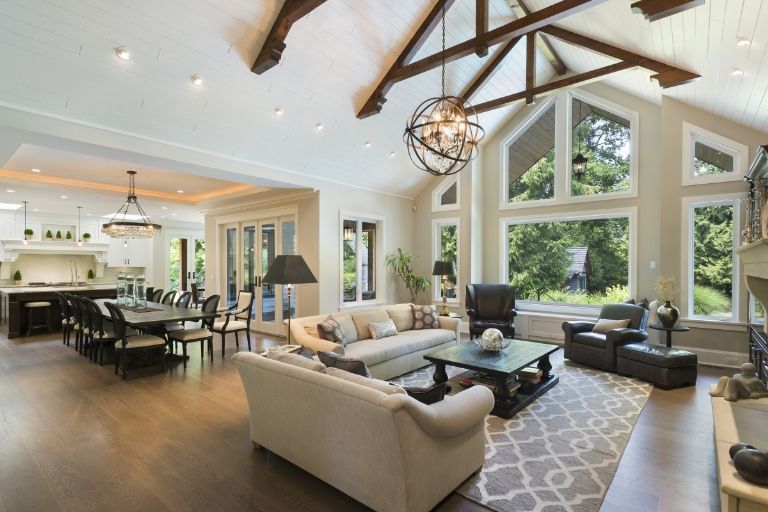In past years there’s been a real movement toward “open concept” living.
Historically, homes were built with rooms being specified for particular purposes, and there wasn’t much crossover.
Kitchens were for cooking, not entertaining and gathering. Dining rooms were for sit-down family meals. A living room was a gathering spot, often more adult-focused, and what used to be called a “rec” room (or “rumpus room”!) was designated as a zone for the kiddos.
In the 1950s, that began to change. After World War 2, there was a more relaxed and casual feeling to home design, and with that we saw the advent of the open floor plan.
By the mid 1990s, open floor plans were fairly common, and today they’re almost the default for new homes (although larger homes often feature an open concept in some areas while also having the luxury of more dedicated single-use spaces).
When working with buyers we often hear that an open floor plan is on their wish list – and many of our clients who remodel rather than move do so in an effort to open up the floor plan of their home.
Open floor plans have many pluses. Yet they have their challenges too. They can be expensive to cool and heat, privacy can be an issue, and there are often noise challenges.
But the complaint I hear most from owners of homes with open floor plans is that they struggle to make the space feel cozy.
Given that most parts of the country are currently “sheltering in place” as I write this, thinking about ways to warm up your open space may be very timely.
Here are our tips on making your open plan home feel cozier and oh-so-welcoming:
DEFINE YOUR SPACES
One of the fastest ways to warm up a space is to tap into the emotional activities that could happen there.
How do you do this? By clearly defining smaller spaces within your large space. These “rooms” can be created by grouping your furniture in a thoughtful way. Create conversation areas, eating areas, reading areas, and/or areas for music in your open space. Your allies in this process will be color, rugs, lighting, layers, and texture.
COLOR
There are two ways you can use color to up the cozy factor in your home. First, because walls, floors, and ceilings incorporate some of the largest areas in the home in terms of sheer square footage, make these areas count! Use color to your advantage in these areas. All white walls are great for art galleries and hospitals, but your home will feel warmer if you use colors (even light hues) on your walls.
The second use of color occurs when you delineate “rooms” within your open concept space by focusing colors in each area you want to define. To keep it all cohesive, carry a bit of the color from each space into the next space.
Finally, keep basic color theory in mind. Yellows, reds, and oranges are considered “warm” because they invoke sun, fire, and deserts. And “cool” colors such as blue, green, and purple remind us of water, sky, or grass. Having said that, there are “warm” blues and “cool” versions of each color – so this is not an exact science. If you want to warm up that open floor plan, give a thought to the color palette you might use to make that happen.
RUGS
Quick, and easy to change, rugs are a great way to warm up your open concept floor plan.
In fact, they’re great on three levels:
- Rugs can add color
- Rugs can add texture
- Rugs can help define the spaces within a larger space
Available in many materials and textures (and an endless variety of colors and styles), the right rug can definitely impact the coziness of your open floor plan.
LIGHTING
Here in the Pacific Northwest, we have our fair share of rainy weather – and most of us crave lots of light in our home. While a well-lit home is appealing in our grey climate, would it surprise you to learn that less bright lights actually make a space appear cozier?
It’s true! A less bright light will hide imperfections and makes everything cozier (think of having dinner in a booth at your favorite restaurant if you’re not sure about this!). Dimmer switches can go a long way toward tweaking the mood, as can adding floor lamps and task lighting.
ADD LAYERS
One of the fastest ways to warm up a space is through the addition of layers and textures. Think throws, pillows, and artwork. Vignettes in key areas draw your eyes, and your emotions, and encourage people to congregate in certain spots.
Natural materials, and a variety of them, can add warmth. Think wool, mohair, burlap, cashmere, silk, rattan, and more. A mix of textiles adds interest depth and warmth. And upholstered furniture is much warmer – both visually and tactilely – than leather.
And with the advent of DIY products such as Stikwood, it’s now easier than ever to add warmth through the application of wood walls or ceilings.
GIVE IT A TRY!
Many of these “fixes” have the added bonus of being fairly inexpensive – and some, such as rearranging your furniture – are free!
Look around your own open spaces. Are you happy with how the look and feel? If you feel they need cozying up, try a few of our suggestions … and let us know the results!
